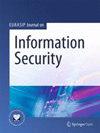The design of network security protection trust management system based on an improved hidden Markov model
IF 2.5
Q2 COMPUTER SCIENCE, INFORMATION SYSTEMS
引用次数: 0
Abstract
With the growth of the Internet, network security issues have become increasingly complex, and the importance of node interaction security is also gradually becoming prominent. At present, research on network security protection mainly starts from the overall perspective, and some studies also start from the interaction between nodes. However, the trust management mechanisms in these studies do not have a predictive function. Therefore, to predict trust levels and protect network security, this paper innovatively proposes a trust management system for network security protection based on the improved hidden Markov model. The research divides the trust level of inter-node interactions by calculating the threat level of inter-node interactions and predicts the trust level of inter-node interactions through an optimized hidden Markov model. In addition, the study designs an estimation of the types of interactive threats between nodes based on alarm data. The research results show that when inactive interaction tuples are not excluded, the average prediction accuracy of the combined model is 95.5%. In response time, the maximum values of the active and passive cluster management pages are 38 ms and 33 ms, respectively, while the minimum values are 16 ms and 14 ms, with an average of 26.2 ms and 24 ms, respectively. The trust management system designed by the research institute has good performance and can provide systematic support for network security protection, which has good practical significance.基于改进隐马尔可夫模型的网络安全防护信任管理系统设计
随着互联网的发展,网络安全问题日益复杂,节点交互安全的重要性也逐渐凸显。目前对网络安全防护的研究主要从整体角度出发,也有一些研究从节点间的交互角度出发。然而,这些研究中的信任管理机制并不具有预测功能。因此,为了预测信任水平,保护网络安全,本文创新性地提出了一种基于改进隐马尔可夫模型的网络安全保护信任管理系统。本研究通过计算节点间交互的威胁等级划分节点间交互的信任等级,并通过优化的隐马尔可夫模型预测节点间交互的信任等级。此外,研究还设计了一种基于告警数据的节点间交互威胁类型估计方法。研究结果表明,在不排除非活跃相互作用元组的情况下,组合模型的平均预测精度为95.5%。在响应时间方面,主动和被动集群管理页面的最大值分别为38 ms和33 ms,最小值分别为16 ms和14 ms,平均分别为26.2 ms和24 ms。该研究所设计的信任管理系统性能良好,可为网络安全防护提供系统支持,具有良好的现实意义。
本文章由计算机程序翻译,如有差异,请以英文原文为准。
求助全文
约1分钟内获得全文
求助全文
来源期刊

EURASIP Journal on Information Security
COMPUTER SCIENCE, INFORMATION SYSTEMS-
CiteScore
8.80
自引率
0.00%
发文量
6
审稿时长
13 weeks
期刊介绍:
The overall goal of the EURASIP Journal on Information Security, sponsored by the European Association for Signal Processing (EURASIP), is to bring together researchers and practitioners dealing with the general field of information security, with a particular emphasis on the use of signal processing tools in adversarial environments. As such, it addresses all works whereby security is achieved through a combination of techniques from cryptography, computer security, machine learning and multimedia signal processing. Application domains lie, for example, in secure storage, retrieval and tracking of multimedia data, secure outsourcing of computations, forgery detection of multimedia data, or secure use of biometrics. The journal also welcomes survey papers that give the reader a gentle introduction to one of the topics covered as well as papers that report large-scale experimental evaluations of existing techniques. Pure cryptographic papers are outside the scope of the journal. Topics relevant to the journal include, but are not limited to: • Multimedia security primitives (such digital watermarking, perceptual hashing, multimedia authentictaion) • Steganography and Steganalysis • Fingerprinting and traitor tracing • Joint signal processing and encryption, signal processing in the encrypted domain, applied cryptography • Biometrics (fusion, multimodal biometrics, protocols, security issues) • Digital forensics • Multimedia signal processing approaches tailored towards adversarial environments • Machine learning in adversarial environments • Digital Rights Management • Network security (such as physical layer security, intrusion detection) • Hardware security, Physical Unclonable Functions • Privacy-Enhancing Technologies for multimedia data • Private data analysis, security in outsourced computations, cloud privacy
 求助内容:
求助内容: 应助结果提醒方式:
应助结果提醒方式:


